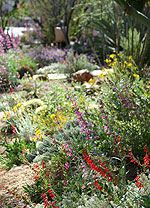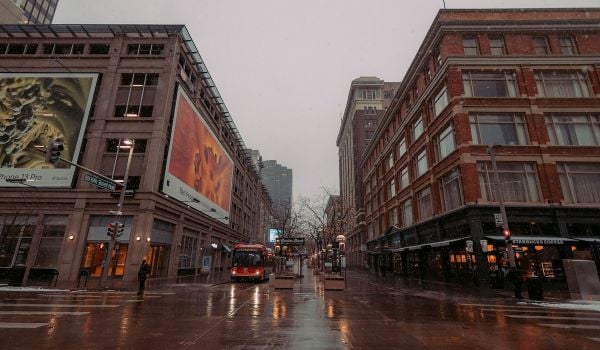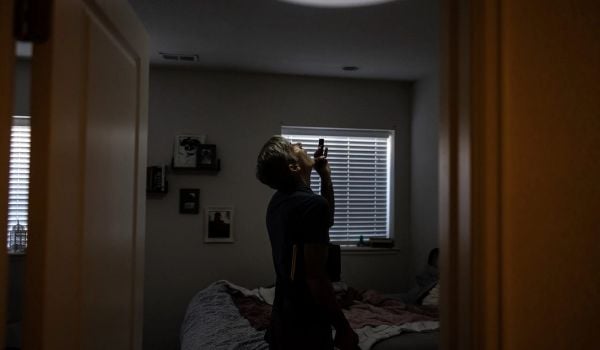Once again spring has dazzled us with vibrant wildflowers, but that spells trouble for the master-planned communities that spread like invasive weeds along the edges of urban areas across the West. Take, for example, my own community of Civano in southeast Tucson, Arizona — a New Urbanist subdivision founded in 1998 that prides itself on resource efficiency and environmental preservation. In Civano, it’s common to see yards bursting with the golds, whites, and brilliant pinks of desert wildflowers like brittlebush, chicory, and penstemon. It’s common, too, for residents to let the annuals fade and go to seed, hoping for another showy display the following year (pending our undependable rains). As the author Joseph Wood Krutch has said, wildflowers of the arid West “riot briefly and then lie low.” Ah, but what a riot it can be.

A riot of wildflowers on our street in Civano. Worthy of two “weed cards,” so far. Photo by Simmons Buntin.
There has been another kind of flash this season, too — the mailing of nearly 200 “weed cards,” postcards noting that a troupe of CC&R committee members found the homeowner’s yard to be in violation. The general culprit: weeds. Another possibility: a shabby yard. The bottom line: though Civano’s landscape guidelines provide for a wide variety of native flowers, the legally-binding covenants, codes, and restrictions reign in the less manicured yards.
And that has people up in arms, as anyone privy to Civano’s online forum or the HOA Board meetings can attest. I’m as guilty as anyone, receiving two cards this season — which means four distinct times CC&R committee members have noted my yard’s non-compliance, for each card is sent only after the second site tour finds a continuing problem. The first card was legitimate; the second seemed wrong, pointing to the source of most of the community’s subsequent outcry: the CC&R committee calling something a weed when in fact it is not. Some residents are so miffed that they have commissioned the creation of a wildflower brochure and checklist for those who gauge violations.
Civano is the first neighborhood in which I’ve owned a home that has a homeowners association. Previously, I lived in a clapboard bungalow in Denver’s Berkeley Park neighborhood. Our house was built in 1903, the house next door in 1929, and the brick ranch across the street in 1950. It was an eclectic neighborhood with lovely tree-lined streets, flagstone sidewalks, and alleys behind homes. We had no HOA, let alone CC&Rs. Yards were a mix: some were lavishly landscaped, fronting large Denver Squares or Victorians — a clear source of pride for homeowners and neighbors alike. Some were basic lawns with little ornamentation. And a good many were in various states of repair. I remember the grand plans my wife and I had for our yard, before expending our allowances on other, more essential items such as upstairs plumbing.

A corner lot in Civano warranted special notation from Civano’s CC&R Committee, which asked: Is it too shabby? Photo by Simmons Buntin.
I don’t once recall wishing there was a quasi-governmental, neighborhood-based organization that defined how ragged our yards could or could not be. I’m sure, though, that I wasn’t fond of some of the yards, or the occasional car up on blocks, or the tarp-covered cord of firewood. Yet I must admit that even these eyesores were a part of the neighborhood’s charm — the rich mix, the occasional surprise, of the urban yard.
In suburbia, however, the yard equation appears to be something akin to C + SL = HPV:
Conformity + Sterile Landscaping = Higher Property Values
And that, apparently, equals happy homeowners. Never mind that many neighbors moved to Civano and communities across the West not so much for property value as for community — the ability to interact with neighbors in a neighborhood of lush native landscaping and regional architecture. Officially, Civano is the Community of Civano, after all.
Landscaping battles such as these have prompted garden writer and Civano resident Scott Calhoun to promote his Desert Gardener’s Bill of Rights for Homeowners Associations. It will appear in his forthcoming book, The Hot Garden, but certainly isn’t limited to desert communities. According to Calhoun’s Bill of Rights, homeowners shall have the right to grow annual and perennial wildflowers in their yard and let the seed on the plants mature before cleaning them up; harvest rainwater to water their garden; grow any native plants found within the wild within 50 miles and at an elevation of 1,000 feet above or below their lot; maintain their plants in natural forms that are not pruned into balls and boxes; and have a yard that is dormant during cold and dry spells, among others.

Even the weeds can be beautiful, as this desert dandelion seed head proves. Still, it must go. Photo by Simmons Buntin.
This Gardener’s Bill of Rights gets to the heart of preserving natural landscapes and features within the city. It seems to me that the only way for cities to remain healthy for generations is to grow in concert with the natural environment. Naturally landscaped yards are not only beautiful; they also promote natural drainage, provide wildlife habitat, assist in cleaning air and water, and help establish that increasingly elusive “sense of place.”
Yet wildflower wars like ours are being waged across the West, and it’s not just yards that are at stake. It gets to the very seed of our flowery souls.
Subscribe now to our national urban issues magazine! Click here for more details! Or, check out our events calendar and find out how you can get involved with the revitalization of your city!















